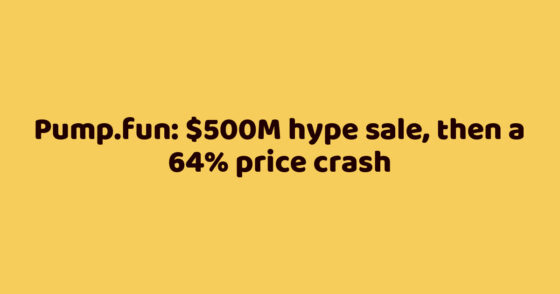On 31 October 2008, the Bitcoin White Paper was published, a technical document describing the world’s first payment system based on blockchain technology. Decentralised, confidential and independent of governments.
Who exactly published this document and developed bitcoin is still unknown. Its author (or authors) used the pseudonym Satoshi Nakamoto and kept in touch with other bitcoin enthusiasts such as Hal Finney until 2010, when he disappeared from public view.
During these 15 years, bitcoin and the cryptocurrency industry built on it have experienced many shocks, falls and highs:
2009 – The first bitcoin exchange rate was recorded: 1309 BTC could be bought for $1;
2010 – Laszlo Heinitz buys 2 pizzas worth $42 for 10,000 BTC. In the same year, the largest crypto exchange at the time – Mt. Gox – appears;
2011 – Bitcoin is valued at $1 and the first alternative cryptocurrencies appear;
2012 – Silk Road, Coinbase and BitPay start accepting BTC. However, it is better not to remember SilkRoad;
2013 – Bitcoin’s first rally to the $1200 mark, followed by a fall. Regulators start to pay attention to cryptocurrencies;
2014 – Mt. Gox hacked and shut down. Users lose 850,000 BTC;
2015 – EU allows bitcoin to be used on its territory. In addition, the largest blockchain network to date, Ethereum, is launched;
2016 – Ethereum experiences its biggest crisis to date. The DAO hack resulted in 15% of all ETH being in the hands of hackers. To save the situation, the community performs a blockchain hardfork;
2017 – Cryptocurrencies become popular. Bitcoin reaches $20,000. Blockchain projects and ICOs are launched en masse;
2018 – China completely bans the use of cryptocurrencies. Investors start to lose interest due to fraudulent ICOs and volatility. The market falls;
2020 – Decentralised finance (DeFi) emerges. Cryptocurrency owners get a decentralised analogue to the banking sector;
2021 – Bitcoin price hits $65,000. NFT and blockchain gaming become popular;
2022 – The fever ends. Several large companies go bankrupt and investors exit the market en masse. Bitcoin falls below $20,000;
2023 – The bitcoin and Ethereum ecosystems actively develop. Governments and banks start to use blockchain for their own needs.
And here we are – 2024. The cryptocurrency market capitalisation is almost $2.5 trillion, bitcoin is worth over $60,000. Even US government bonds and real estate are now available on the blockchain.
But how do you know if this is a good time to enter the crypto market? And more generally, what is happening in the industry globally right now? To answer these questions, we need to look to the past – if we understand what happened before the “here” point, we can understand where exactly the “here” point is.
The dawn of a new era in technology and finance
In history there is a concept of “before our time”, and in the crypto industry we use the term “before bitcoin”. Everything that happened before bitcoin is undoubtedly important, but it is the 31st of October 2008 that is considered the birth of the industry.
On that day, Satoshi Nakamoto published the Bitcoin White Paper. It is a nine-page document that describes the operating principles of the world’s first decentralised payment system.
Satoshi Nakamoto’s identity remains a mystery, but as an early bitcoin user he still holds 1.1 million BTC.
BTC is the ticker symbol or name for bitcoin, like USD for the dollar.
Before bitcoin, digital networks were centralised and relied on a server to store personal data, payment records and other important information.
The owner of the server, with monopoly access to the data, can make any changes and manipulations. Users have no part in this process and can only passively receive information.
To empower all participants in the network and eliminate the vulnerability of centralised servers, a new type of architecture – blockchain – has been developed. In which:
Information is publicly available;
copies of this information are stored on many devices (nodes);
all these copies are constantly synchronised.
It is impossible to change the data stored in the blockchain – a user can only edit his own copy. But to avoid conflicts with other nodes, all owners must agree on these changes. Furthermore, everyone can see exactly what has been changed and by whom.
This transparency and publicity ensures security and lack of manipulation, but it undermines the foundations of privacy. To solve this problem, interactions with the blockchain take place using accounts (wallets) that do not store personal user data. And access to these records is protected by cryptographic encryption.
Bitcoin is a decentralised network in which users can transfer BTCs to each other anonymously and without intermediaries.
The Bitcoin White Paper describes a transparent payment system outside the control of any organisation or government. In 2008, however, the world was struggling with the effects of the global financial crisis, and the emergence of a new technology for storing and protecting data attracted little interest.
A brief history of the cryptocurrency market
Now that we have established when and how the crypto industry as we know it emerged, we can move on. It has been 16 years since the publication of the Bitcoin White Paper, during which time the market has undergone several global restructurings and been on the brink of extinction.
2009: it’s still worth something
In 2009, the first bitcoin-dollar exchange rate was recorded. It was based on the cost of electricity used to confirm transactions on the network (mining). It was possible to buy 1309 BTC for $1.
2010: Pizza for Bitcoin
In 2010, the first exchange of digital currency for real goods took place – a bitcoin developer paid 10,000 BTC for two pizzas, which cost $42 at the time.
This became a landmark event for bitcoin, and now Bitcoin Pizza Day is celebrated every year on 22 May.
2011: the era of altcoins
In 2011, altcoins, or alternative cryptocurrencies to bitcoin, began to emerge. The first to appear were Namecoin and Litecoin.
Altcoins are an attempt by developers to address the shortcomings of bitcoin and add new functionality. Their emergence indicates a growing interest in the technology and the formation of a new community around it. It was in the era of altcoins that cryptocurrency and blockchain began to develop as a separate industry.
2013: the first cryptozyme
In 2013, the value of bitcoin rose from $30 to $266. However, many users considered the cryptocurrency to be an illegal payment instrument distributed on the Silk Road marketplace. That same year, Silk Road was shut down and its founder arrested.
With the closure of the platform, bitcoin was less associated with illegal activities and investor interest grew, as did the price, which reached $1242.
It is interesting to note that when Silk Road’s founder was arrested, more than 9,000 BTC were seized from him, which went to the US government.
In the same year, China imposed a total ban on cryptocurrencies and the Mt. Gox exchange, which handled 47% of all bitcoin transactions, was attacked by hackers and 850,000 BTC were stolen. Following these events, the value of the asset plummeted, beginning a prolonged two-year decline and stagnation at the $200-300 level.
2011: the era of altcoins
In 2011, altcoins, or alternative cryptocurrencies to bitcoin, began to emerge. The first to appear were Namecoin and Litecoin.
Altcoins are an attempt by developers to address the shortcomings of bitcoin and add new functionality. Their emergence indicates a growing interest in the technology and the formation of a new community around it. It was in the era of altcoins that cryptocurrency and blockchain began to develop as a separate industry.
2013: the first cryptowinter
In 2013, the value of bitcoin rose from $30 to $266. However, many users considered the cryptocurrency to be an illegal payment instrument distributed on the Silk Road marketplace. That same year, Silk Road was shut down and its founder arrested.
With the closure of the platform, bitcoin was less associated with illegal activities and investor interest grew, as did the price, which reached $1242.
It is interesting to note that when Silk Road’s founder was arrested, more than 9,000 BTC were seized from him, which went to the US government.
In the same year, China imposed a total ban on cryptocurrencies and the Mt. Gox exchange, which handled 47% of all bitcoin transactions, was attacked by hackers and 850,000 BTC were stolen. Following these events, the value of the asset plummeted, beginning a prolonged two-year decline and stagnation at the $200-300 level.
2018: the second cryptowinter
At the beginning of 2018 – the market looked like a burst bubble. The “crash” of bitcoin began to be compared to the dotcom bubble, when no one understood why companies like Amazon were needed, but everyone said they missed the opportunity to make money with them.
Back then, everyone was sure that cryptocurrency was over. But 2018 is in the past and you are reading this material and you know how much bitcoin is worth.
2019: The revival of ICOs
In 2019, the cryptocurrency exchange Binance launched a new trend – IEOs. This is a new type of ICO that takes place on the exchange according to special rules.
IEO platforms took over the responsibility of selecting projects, and the risk of fraud decreased. The market revived, people began to forget about cryptocurrency, and new users and fresh capital were attracted to the industry.
2020: DeFi boom
DeFi, or decentralised finance, is the next stage of cryptocurrency development after smart contracts and ICOs.
The problem with the early crypto market was that, by default, the blockchain only allowed coins to be sent between wallets. That’s enough for everyday use, but not enough to replace traditional finance with banks, deposits and loans.
Two breakthrough technologies, the aforementioned smart contracts and automated market makers (AMMs), made it possible to build a full-fledged banking replacement on the blockchain.
Ethereum and other networks began to create marketplaces where cryptocurrency owners could earn money by lending their assets or providing liquidity for coin exchanges. For the first time, it was possible to exchange cryptocurrencies without relying on centralised crypto exchanges and ‘bulletin boards’.
2021: NFT
In 2021, the market has discovered the technology of NFT or non-replaceable tokens.
While regular tokens are like banknotes – one can easily replace the other – NFT is more like a certificate or document of ownership of something. That is, it is unique and exists in only one copy.
NFTs allow the ownership of digital objects to be recorded on the blockchain, eliminating the possibility of counterfeiting. The technology appeared on the Ethereum network in 2018, but the real boom came in 2021:
Digital artists like Beeple started selling their work as NFTs;
The first trading platforms for exchanging digital objects appeared;
Creators and communities published image collections for their users;
Developers will try to integrate NFTs into games. Remember those expensive virtual coaches? They are NFTs too.
The biggest demand was for so-called PFPs – unique avatars for social networks in the form of NFTs. Some pieces from cult collections like Bored Ape Yacht Club (BAYC) or CryptoPunks cost up to several hundred thousand dollars.
2022: Stage 2
After the boom of DeFi and NFT, the Ethereum network, where most projects operate, faced a scalability problem – the number of transactions was growing, but there was no way to speed up their processing, leading to higher fees, queues and inconvenience for users. The breakthrough solution was Layer 2 (L2) networks, and the first projects in this direction were Arbitrum and Optimism.
The offloading of the main network and cheap L2 transactions were the driving forces behind the revival of DeFi and the development of new directions in the sector, such as decentralised platforms for derivatives trading. This has opened up additional money-making opportunities and revitalised the Ethereum ecosystem.
2024: what’s next?
Despite a challenging macroeconomic environment and continued price declines, the market continued to evolve in 2023. Several new technologies and trends emerged last year, including:
Smart wallets for Ethereum;
Zero disclosure proofs (ZKP);
NFT and the beginnings of a DeFi ecosystem for bitcoin;
Artificial intelligence on the blockchain;
Liquidity stacking and restacking.
In addition, projects began to use airdrops to attract users and incentivise user activity. A further development of this model was the so-called points (pints), which were widely used in 2024.
This chronology clearly shows that the development of the crypto industry is cyclical and happens in leaps and bounds. And this is normal. This is exactly how revolutionary technologies like the internet developed in their time.
First rejection, then rapid growth, then the bubble bursts. Fraud projects die, but the technology remains, and the new industry begins a systematic and stable development.
Is it already too late?
Is it too late to join the blockchain industry? You really missed a lot of the early market, such as the lack of exchanges with user-friendly interfaces, cumbersome wallets and hacks of monopoly trading platforms.
But if you think it’s “too late” now, here are some numbers to understand our entry point: as of February 2023, the number of bitcoin wallets with non-zero balances was estimated at 44 million. Assuming each one is owned by an individual, that’s only 0.8% of the total internet population.
We’re still in the early stages of the industry. And a lot of people think about blockchain and cryptocurrencies in the same way people used to think about the disruptive technologies of their time: they’re neither useful nor harmful, they’re not technically feasible, they won’t take off.
That’s what they used to say about railways, cameras and iPhones. But we all know how history turned out.
Hopefully the “we are here” point is now more clearly positioned in your mind.
What’s in store for us? Fake and unnecessary startups will die, and niche projects that solve specific problems will remain. Convenient and understandable applications will emerge, making it much easier to interact with cryptocurrencies. The scope of digital assets and blockchain technology will expand significantly, and the number of users will grow. So no, you are not “too late”.
In our training course you will learn what bitcoin and NFT are, how blockchain works, why trading is necessary and how to distinguish secure crypto exchanges from fraudulent ones. Our aim is to provide useful information, build a basic knowledge of cryptocurrencies and help new users find their place in the industry.








